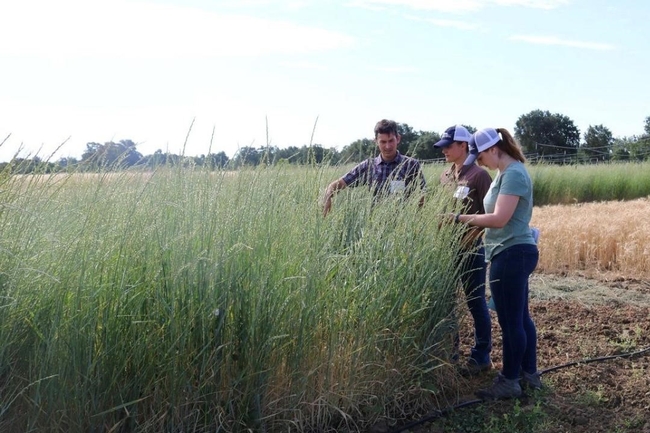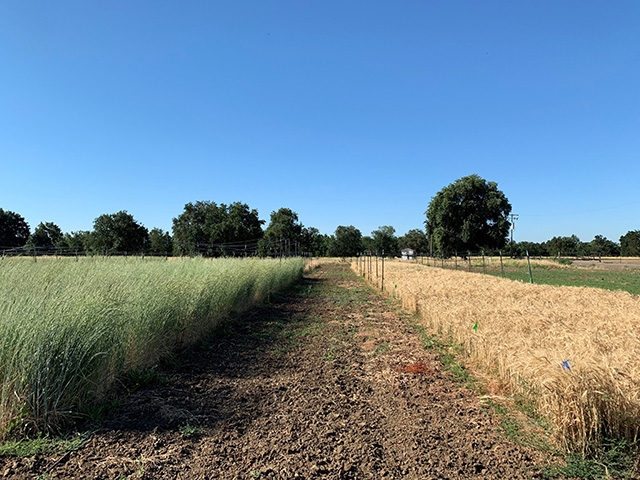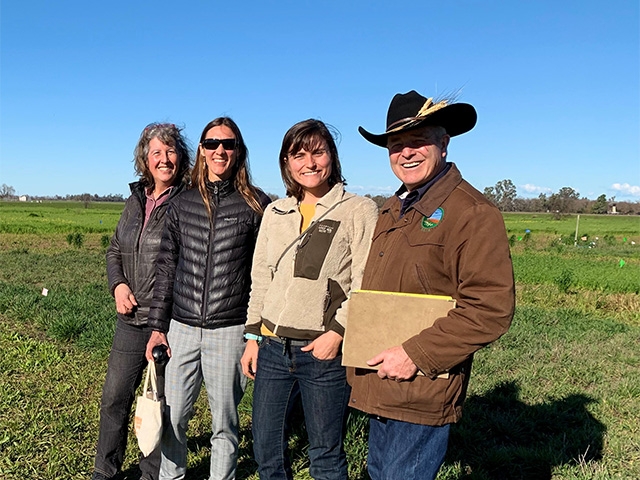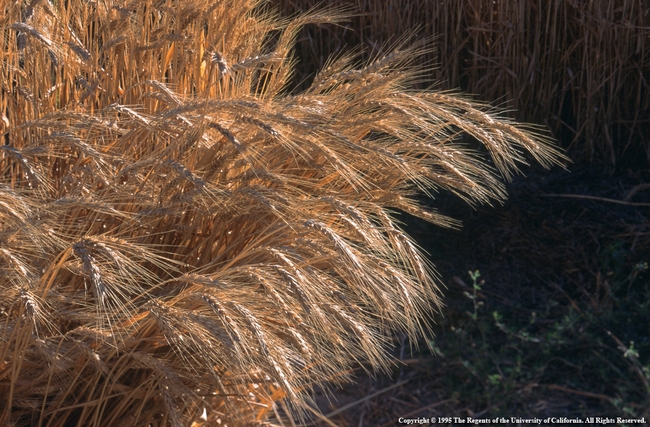Posts Tagged: Wheat
No-till annual wheat better for soil health in California’s climate
One more reason to adopt sustainable cultivation
California wheat farmers could both maintain their yields and improve soil health by growing annual wheat without tilling the soil year after year.
This could be one more encouragement to farmers to adopt a sustainable practice commonly called conservation tillage, no-till or minimum-till cultivation, impacting how we grow a grain that supplies about 20 percent of the calories and protein for people around the world.
A new study, by a team led by Mark Lundy, University of California Cooperative Extension specialist in UC Davis' Department of Plant Sciences, offers new insight for decades-long discussions around soil conservation, sustainable agriculture and climate-warming emissions related to growing our food. The study has been published in the journal Soil and Tillage Research. For the first time, researchers have shown that annual wheat that is not tilled each year is better for stashing carbon in the soil than perennial wheatgrass, while still yielding more crop in Central California.
Previous studies have looked at annual wheat that is tilled each year, annual wheat that is not tilled, and a cousin species, perennial intermediate wheatgrass (trademarked Kernza), which also is not tilled. But until now, no one has looked at all of the benefits and trade-offs together. Most importantly, “no one has ever controlled for tillage,” Lundy said. “And, no one has compared annual wheat to perennial intermediate wheatgrass over multiple years in a Mediterranean climate, which is what we have in California.”
This study also is unique because it delves into the deeper question of what is going on in the soil that drives the different results for carbon there. Soil carbon reflects various processes linked to plant activity and soil health. Measuring the different forms of soil carbon may also signal whether a farming system is accumulating carbon in the soil over time – a plus for reducing climate-warming gases in the atmosphere.
“Measuring soil carbon is complex and nuanced,” said Kalyn Taylor, the lead author on the paper. “We started this experiment because we wanted to know whether and how plant activity and tilling or not tilling would affect the carbon story belowground in California's climate.”
“When we started this study, we thought the crop being perennial or annual would drive the differences in carbon storage in the soil,” Lundy added. Specifically, they had expected perennial wheatgrass would lead to more carbon in the soil because of its deeper, better-established root system. “But that's not what we found,” he went on. “What we found was, it was the lack of tillage, plus the level of productivity of common annual wheat, that made the difference in soil carbon here in California.”
Soil carbon in annual vs. perennial grain
In 2017, Lundy, then-graduate-student Taylor, UC Davis Professor Emeritus Kate Scow and others on the team started measuring different forms of soil carbon in test plots at Russell Ranch, west of campus. Plots were planted with annual wheat that was tilled each spring, annual wheat that was not tilled and perennial intermediate wheatgrass (Kernza) that also was not tilled.
Each year, the researchers measured the carbon present in the soil, the amount of soil organisms (which have carbon in their bodies) and the amount of material the plants created.
At the end of three growing seasons, they found that land planted with no-till, common, annual wheat had the highest amount of soil organisms, measured as biomass, of the three treatments.
The researchers also found soil carbon is more likely to remain stable in the no-till, annual plots, compared to both tilled wheat and wheatgrass.
In addition, the no-till, annual wheat produced plant material more consistently than the perennial wheatgrass across the three years, which saw variation in rainfall.
“Overall, annual wheat grown without soil disturbance or tillage had both higher productivity and higher potential for storing carbon in the topsoil than perennial wheatgrass in our Mediterranean climate,” Lundy said.
Related research
“No-till annual wheat increases plant productivity, soil microbial biomass, and soil carbon stabilization relative to intermediate wheatgrass in a Mediterranean climate,” is online now and will be published in the January 2024 edition of Soil and Tillage Research.
The team also found that tilled annual wheat vs. Kernza stores total carbon at different depths in the soil profile and hosts distinct soil fungal communities, primarily in the root zone and topsoil: Taylor, K., Samaddar, S., Schmidt, R., Lundy, M. and Scow, K., 2023. Soil carbon storage and compositional responses of soil microbial communities under perennial grain IWG vs. annual wheat. Soil Biology and Biochemistry, p.109111.
Previous work comparing the perennial grain known as intermediate wheatgrass (trademarked Kernza) to annual wheat had not distinguished the extent to which soil health benefits are a function of the perennial nature of the crop. Read the story here.
This story was originally published on the UC Davis News site.
Research Updates: Biosolids as a Nitrogen Source in California Wheat
Overview Three years of data indicate that liquid-injected biosolids-based fertilizers (LBF, using 'Lystegro' from Lystek) are a viable alternative to conventional forms of nitrogen (N) fertilizer on a total N basis in wheat rotations in the...
Yolo County Nitrogen Management Webtool Seminars for CCAs, Growers, and Crop Consultants
Join us next week for a workshop that will cover some basic wheat fertilization strategies and focus on how to use the Nitrogen Fertilizer Management for California Wheat Webtool. Yolo County: Wednesday, October 11th 2023, 9 a.m. – 11:00...

Rio Vista Trial Area
Regional Italian ryegrass herbicide trials underscore the importance of IPM in weed management
Summary Review Results from this year's Italian ryegrass (IR) herbicide trials helped quantify differences in herbicide resistance among IR populations within the southern Sacramento Valley. The trial took place in Bird's Landing, CA (near Rio Vista),...
Global food security threatened by grain export disruptions
Wheat and corn prices have spiked after Russian aggression in the Black Sea
The Russian invasion of Ukraine in early 2022 caused wheat and corn prices to spike 30% and 13%, respectively, and threatened a worldwide food crisis. International efforts to mitigate a food security crisis via the Solidarity Lanes and the Black Sea Grain Initiative (BSGI) have successfully allowed grain exports out of Ukraine. However, Russia's recent withdrawal from the BSGI, coupled with increased bombings of Odesa and Danube River ports, caused another price spike for these grains. Further aggression in the region risks halting Russian wheat and Ukrainian corn exports across the Black Sea, the main export channel for both countries.
Russia accounts for about 18% of global wheat exports and 2% of worldwide corn exports, while Ukraine provides 15% of global corn exports and only 9% of wheat. Why have these statistics spooked the grain commodity markets?
“The simple answer is that Russia's aggression in the Black Sea region increases the risk of the world grain market losing the number four corn exporter, Ukraine, and the number one wheat exporter, Russia, if grain vessels on the Black Sea become targets of drone strikes,” said Colin A. Carter, Distinguished Professor of Agricultural and Resource Economics at the University of California, Davis. If all grain shipped through the Black Sea by Russia and Ukraine were halted, it would cut off 27% of global wheat exports and 17% of global corn exports.
Analysis of the corn and wheat markets by Carter and Sandro Steinbach, associate professor in the Department of Agribusiness and Applied Economics and the Director of the Center for Agricultural Policy and Trade Studies at North Dakota State University, shows a notable increase in market uncertainty since the start of the Russia-Ukraine War, as evidenced by measuring "implied volatility." Implied volatility is the expected price volatility of a commodity like corn or wheat in options trading. In March of 2022, shortly after the invasion of Ukraine, the implied volatility of corn jumped from 25% to 60%, while wheat rose from 40% to 160%. There was also a second peak in volatility in July 2023, after Russia pulled out of the BSGI, suggesting further fears that grain exports through the Black Sea could be cut off from world markets.
When Russia withdrew from the BSGI, there was another brief price spike in wheat (up 15%) and corn (up 10%). Wheat markets have been consistently more affected by conflict in Ukraine, specifically in the Black Sea, than corn prices. This difference can be explained by the fact that 95% of Russian grain is exported through the eastern portion of the Black Sea, while around a quarter of Ukrainian grain is shipped by truck and rail and would not be as affected by the conflict in the Black Sea. By volume, there is around 1.7 times more wheat than corn shipped from Black Sea ports. The wheat market is more politically charged than the corn market because wheat is primarily a food grain. Therefore, the greatest risk to global food security moving forward may no longer be getting grain out of Ukraine – due to the continued success of the Solidarity Lanes – but rather the loss of wheat exports to the world market that could result from Russia backing out of the Black Sea Grain Initiative.
To learn more about how Russian aggression in the Black Sea might affect global food security, read the full article by Carter and Steinbach, “Russian Weaponization of Food Rattles Global Markets,” ARE Update 26(6): 1–4. UC Giannini Foundation of Agricultural Economics, online at https://giannini.ucop.edu/filer/file/1694637435/20778/.
ARE Update is a bimonthly magazine published by the Giannini Foundation of Agricultural Economics to educate policymakers and agribusiness professionals about new research or analysis of important topics in agricultural and resource economics. Articles are written by Giannini Foundation members, including University of California faculty and Cooperative Extension specialists in agricultural and resource economics, and university graduate students. Learn more about the Giannini Foundation and its publications at https://giannini.ucop.edu/.




